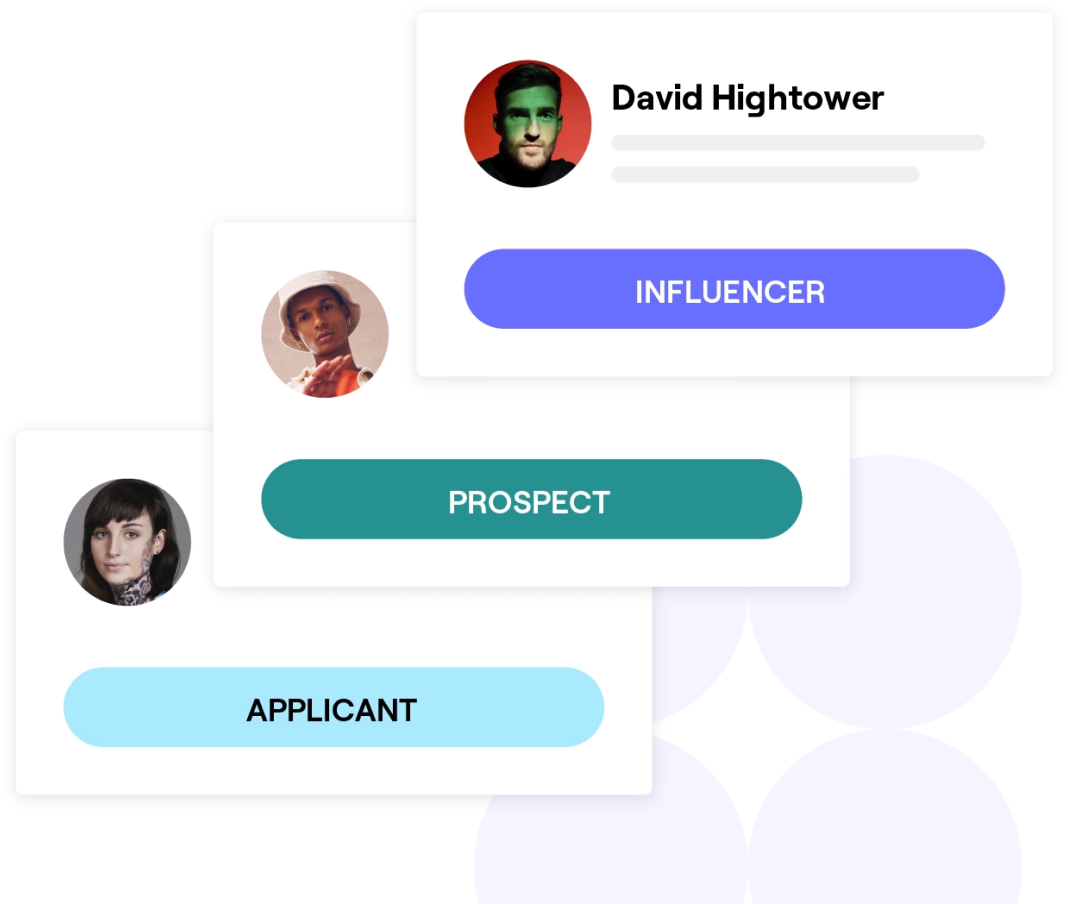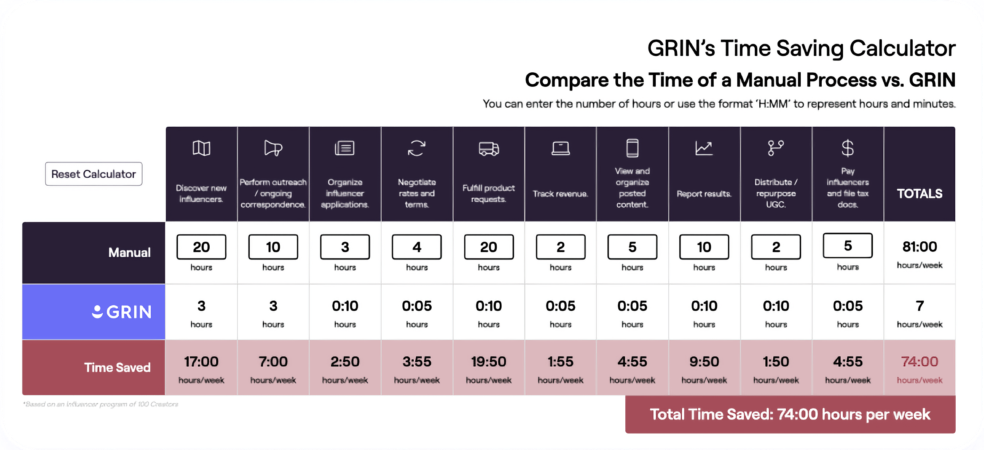It seems like everyone nowadays is talking about influencer marketing. And it’s for a good reason. Influencer marketing is one of the best techniques for creating authentic connections with new and existing customers, and with an average ROI of roughly $6.50 for every $1 spent, what’s not to love?
And while it’s tempting to dive right in and get started, doing so can leave you with some blindspots that can negatively impact your results.
Instead, take some time to thoroughly research and plan out your program. You’ll be grateful for this organization when the sales start rolling in.
And while there’s always some level of testing required to see what works and what doesn’t, we’re sharing the top 15 influencer marketing mistakes for you to avoid altogether. Let’s dive in.
1. Mistaking celebrity endorsements as the only type of influencer marketing
While celebrities are a type of influencer, they aren’t the be-all and end-all of the creator economy. In fact, they only make up a small portion. Creators with any size following can be great partners for your brand. Here’s a breakdown of the types:
- Nano influencer: 1,000-10,000 followers
- Micro influencer: 10,000-100,000 followers
- Macro influencer: 100,000-1M followers
- Mega/celebrity influencer: 1M+ followers
Many brands, especially those just getting started, don’t have the funds to partner with celebrities, and that’s totally ok! In fact, while mega influencers are great for building a massive amount of brand awareness, they typically don’t have the same level of authentic engagement as smaller creators, which is essential for building brand love and encouraging purchases.
Additionally, since a mega influencer has so many followers, only a percentage of them will fit within your target audience, so you’re spending money to reach more people who aren’t necessarily relevant. In contrast, a smaller influencer offers lower rates and can help brands reach more targeted audiences.
How to fix it: While there isn’t much you can do after signing contracts with influencers, use this knowledge moving forward in future campaigns.
2. Skipping over nano and micro influencers because of their smaller followings
Small creators have the time to nurture authentic relationships with their followers, which can often lead to more trust and sway over purchasing decisions.
Plus, many nano and micro influencers focus on a niche topic, and the people who follow them tend to be passionate about it. If your brand offers products or services that fit within that niche, you can reach an extremely targeted audience.
How to fix it: If your budget allows you to include a few posts from nano and micro influencers, invite some to join your campaign. If you’ve run out of funds right now, go into your next campaign with the intention of working with smaller creators.
3. Not researching influencers before reaching out
One of the first metrics that marketers will look at is follower count, and when this is the main factor you’re basing a decision on, you could be setting your program up for less than stellar results.
Once you find some interesting creators, it’s time to do thorough research. We encourage you to look at the following metrics:
- Engagement rate: An engagement rate that’s too low can show that their audience doesn’t connect with their content, while an engagement rate this is exceptionally high could be a sign of bots and fake followers. Check out reasonable engagement rates by follower count, and use this free tool to check a creator’s credibility score.
- Audience demographics: Make sure their follower base has a large number of people that fit into your target audience. Learn how to evaluate a creator’s following.
- Branded content performance: Look to see if they’ve partnered with a brand before. If they have, does the engagement post meet or exceed the engagement on non-branded posts? If not (and their engagement is significantly lower), their branded posts may not be effective, and you should begin to look elsewhere.
How to fix it: If you haven’t signed contracts with the creators, go ahead and research them more thoroughly. If their metrics are ideal, that’s great news! But if they’re less than ideal, you can let them know you’re going in a different direction with the campaign. Do this as gently as possible, though, because this can upset creators.
4. Not personalizing outreach messages for content creators
Sending generic cut-and-paste messages to creators will make them feel like a transaction rather than a potential partner. However, they tend to respond well when they can tell you want to work with them because you truly enjoy their content.
In your outreach, use their name and include details about what you like about their content and why they would be a good fit for your brand.
To make emails even more enticing, add info about potential payment methods in the subject line. This can show creators you mean business.
How to fix it: If you’ve already sent a generic cut-and-paste email and the creator hasn’t responded, try following up with a more personalized note. Feel free to add their name or any specific details in the subject line to grab their attention.
5. Partnering with controversial content creators
Since the basis of a creator’s job is to be in the spotlight, it’s only natural that some will stir up controversies. And while they vary in severity, partnering with controversial creators can lead to distrust for your brand.
The public often becomes upset when brands fund creators who have upset them in some way or another, and they’ll often transfer these negative feelings to your brand. That’s why brands typically end partnerships with creators when a scandal leaks.
A quick Google search of any potential creators is a great way to see if there are any public concerns surrounding them.
How to fix it: If your brand comes under fire for partnering with a controversial influencer, it’s time to craft a public message. Address peoples’ concerns, accept responsibility, and let the people know what you’re doing in response. Sometimes, this can be as drastic as dropping the creator from your roster, but remember, if you already signed a contract with them, you may still have to fulfill your end of the bargain.
6. Partnering with an influencer who doesn’t love your brand
Part of what makes creators such great spokespeople for brands is the connection they have with their fans. Their followers feel like they know them, and they can sense when a creator’s excitement is genuine or manufactured for a paycheck.
If you’re partnering with a creator who doesn’t truly love your product or service, their audience will be able to tell, and they’ll lose trust in the creator and your brand.
How to fix it: Before developing a partnership with a creator, be sure to send them some samples of your product. This allows them to become familiar with it and see if it’s something they gain value from. If it is, then you have the makings of a great collaboration. If they don’t love, it’s time to look elsewhere.
7. Providing either too much or too little freedom in an influencer brief
If you’ve ever been given an assignment at work with absolutely no direction, you probably didn’t know where to start. It’s easy to be overwhelmed when you can do anything under the sun.
That’s why giving some direction to the creators you partner with is essential. However, it’s also possible to provide them with too many requirements. After all, these creators are experts in what their audiences like, so if they have so many restrictions that they can’t deliver their typical content, you won’t get the results you’re looking for.
Influencer marketers must find the sweet spot between too little and too much information. Some things you may want to include in a creator brief include:
- Branded assets: If you have any images, logos, or slogans to include, be sure to add them here.
- Content type: If you’re looking for a static image, short-form video, or carousel post, let your creators know!
- Key benefits: Highlight the most compelling benefits of your product, but don’t make them mandatory to include. Instead, provide them as a little bit of creative inspiration.
- Anything you want the creator to avoid: Tell your creator if there is anything you want them to specifically keep out of their content. For example, if your product is vegan, you may want to tell them to leave any animal products out of their photos or videos.
How to fix it: Take a look at the content brief. If it’s too short, add in some more details and send it back to your creators. If it’s too long, see what you can cut out to give your team a bit more freedom.
8. Overspending on your influencer marketing campaign
Another major influencer marketing mistake is overspending on your campaign.
Overspending on influencer marketing happens mainly because of two reasons. One, the cost of influencer marketing varies from influencer to influencer and campaign to campaign. A campaign that requires a lot of legwork and engagement will cost more than a campaign that requires fewer posts.
The second reason is not knowing exactly how much an influencer charges for an advertising campaign. Influencers do not advertise their fees so they can avoid negotiations with present and future clients.
One key way to avoid overspending is establishing a campaign budget before starting and sticking to it.
How to fix it: If you’re still in the negotiation phase and you realize the costs are a bit too high, begin to look at other creators. Or see where else you can cut costs if you’ve already locked in the contracts. You may have to avoid asking for content usage rights for any posts you really like if you don’t have much budget left.
In the future, set a budget beforehand and stick to it. Reach out to smaller creators, and don’t be afraid to say no if an influencer asks for too much.
9. Not spending enough time planning your influencer marketing strategy
Some brands think that just by running an influencer marketing campaign, the hard work is done. In reality, your hard work should begin even before you have decided to launch an influencer marketing campaign.
Rushing into an influencer marketing campaign can be tempting. However, this can cause serious problems down the line.
Just like launching a successful company requires a proper business plan, an influencer marketing campaign also depends on thorough research and preparation.
How to fix it: Clear some time on your schedule and take a look at your overarching campaign. Then, zoom in on the different parts. See where your strategy is thin, and begin to add more details. If you need help, don’t be afraid to pull in other team members for some new perspectives.
10. Choosing the wrong social media platform
A strong social media presence can do wonders for your business. However, many brands aren’t able to harness the true potential of social media. This is because they choose the wrong social media platforms to reach their audience.
In a world of cutthroat competition, social media has become an integral part of business marketing. Even small businesses have started to maintain their own Facebook and Instagram pages.
So, when planning to launch an influencer marketing campaign, choosing the right social media platform is essential. Doing so will help you connect with the right target audience you need for your brand to grow.
Once you identify the demographics and psychographics of your target audience, do some research into the different platforms. You can find information about social media platforms’ typical users with a quick Google search. See where your audience spends their time, and focus on those.
How to fix it: If you’ve already secured your creators by the time you realize you’re targeting the wrong platforms, see if they’re active on different channels that may be more suitable for your brand. Talk to the creator about switching the platform requirements for their tasks, explain why you want to make this change, and see if they’re open to it.
11. Not tracking the data from your influencer marketing campaign
If you’re not tracking the results of your influencer marketing campaign, you won’t know if it was successful. But when you take the time to measure results periodically throughout the campaign, you can identify what’s working and what’s not, enabling you to make changes and improve your tactics.
If you’re not sure how to track results, no worries. GRIN has put together a few spreadsheets you can download and use for free.
See Also: Influencer Reporting Best Practices for Demonstrating ROI [+ Free Influencer Report Templates]
You can also use a creator management platform to track results automatically, but these can require a decent investment and aren’t the best solutions for small or new influencer programs.
How to fix it: Take some time to put together a spreadsheet with all of the details from your campaign, then add dates into your calendar for when you will check and record metrics. Start tracking the data as soon as possible.
12. Expecting instant results
Influencer marketing is a long-term strategy, and you can’t expect overnight results just by running one campaign. Influencer marketing increases brand popularity and awareness slowly and steadily.

How to fix it: Set some goals, and choose a more reasonable date you want to achieve them by. Then choose some key performance indicators you can measure to track your progress toward your goals. Then, be sure to adjust and optimize your program along the way to make sure you’re getting the best results possible.
13. Measuring success solely through sales
While influencer marketing is great for bringing in sales, that’s not the only way to gain value from this useful technique. Other widely popular campaign foals include:
- Content generation: Producing content on your own can be expensive and typically requires you to work with a team of designers, writers, videographers, and more. Creators can fill all of these roles, often at a much lower price. If you’re hoping to build your content library, be sure to negotiate with each creator for content usage rights from the beginning.
- Brand awareness: Getting more eyes on your brand and informing people about your products or services is a great way to encourage people to investigate further. After learning about your brand, they may start following your branded accounts, head to your website, or even sign up for a mailing list. Therefore, brand awareness is a worthy goal for your influencer marketing campaign.
- Boost SEO efforts: Partnering with reputable bloggers in your niche is an excellent way to improve your search engine rankings, which can lead to more organic traffic to your website.
How to fix it: Sit down and think about different goals your program can achieve. What is most valuable for your business? Once you determine your goal, think of different key performance indicators you can monitor to track your progress, and measure these periodically throughout your campaign.
14. Repurposing influencer content without the proper usage rights
An influencer’s posts are their intellectual property, which means they own the rights to it, even if you paid for them to develop the content on your behalf.
To be able to use it on your social media accounts or in other marketing materials (like emails, ads, or your website), you need to draft a content usage rights agreement that both parties agree to.
Keep in mind: Creators will often charge more for content usage rights, and the longer you want to use the content, the more expensive it will be.
How to fix it: Remove any creator content that you don’t have permission to use from your social channels and other marketing techniques. Then reach out to the creators and own up to your mistake. Ask them if they would be open to giving you content usage rights, and if they say yes, you can work out how much it will cost.
15. Not following FTC guidelines for identifying sponsored content
@rendagrella These @trescolori pieces make me feel like Carrie Bradshaw✨💕 Use code RENDAGRELLA50 for 50% off🥰 #trescolorijewelry #ad ♬ Blue Blood – Heinz Kiessling & Various Artists
While we’re talking about legal trouble, another common concern brands face is not using proper disclosures on sponsored content.
Whenever a creator posts on your behalf (whether it’s a social media video, a blog, or a review on your website), they are legally required to disclose that they received the product or service for free.
Requirements vary by country, but you can find the U.S. Federal Trade Commission guidelines here, the Canadian guidelines here, and the U.K. Competition & Markets Authority’s guidelines here.
It’s best to include the disclosures you want your creators to use in their campaign brief.
How to fix it: If you notice a creator hasn’t added the right disclosures to their posts, ask them if they can edit the captions to add them in. If the posts are on a platform that doesn’t allow for editing, ask them to remove the original and repost with the disclosure.
Key takeaway: Take your time when developing an influencer marketing program.
Now that you know what to watch out for, there’s no stopping you now. Keep these 15 tips in mind, and get to planning. And if you want even more insights into developing and running a successful influencer marketing program, check out our 101 guide.

















